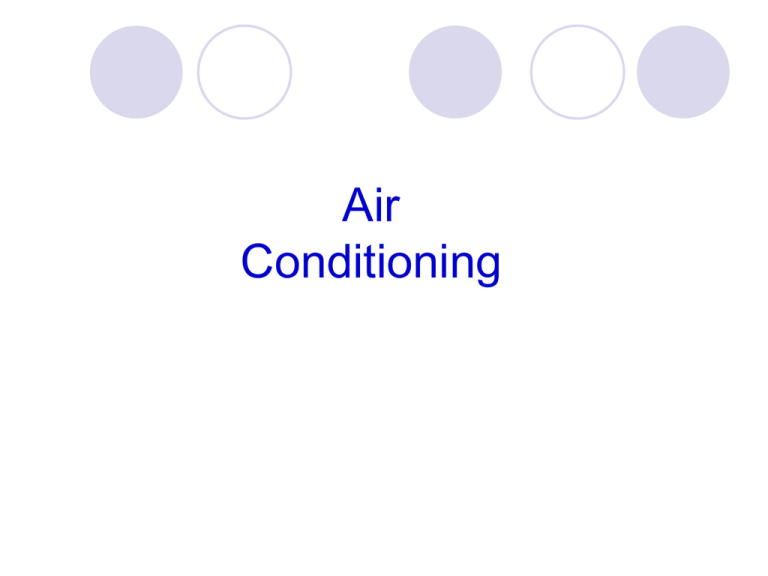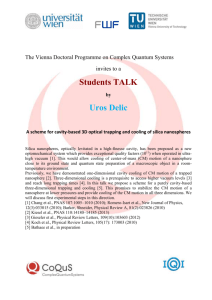
Air
Conditioning
Definition:
Any treatment of the environment air within a building is
air conditioning.
Air cooling is any process that reduces air temperature.
Refrigerated air is produced by a mechanical
refrigeration cycle.
Examples:
Air conditioning: fan that circulates air, filtering air,
heating, cooling, humidifying, dehumidifying
Air cooling: fan blowing, coolers, swamp coolers, open
windows
Refrigerated air: vapor compression, absorption cycles
Basic Refrigeration Cycle
Condenser
Compressor
Expansion
Valve
Evaporator
Terminology
Dry Bulb Temperature
measure of the rate of movement of air molecules
measures the sensible heat of air
conventional thermometer is used
as air molecules move faster
more energy
more sensible heat
no common comfortable dry-bulb temperature 65-72 degrees F?
Wet Bulb Temperature
measure of the total content of the air (sensible plus latent heat).
measured with a conventional mercury-in-glass thermometer is
covered with a piece of cloth that is saturated with water and the
thermometer is exposed to air.
How Hot or Cold?
Factor
Age
Sex
Activity
Clothing
Diet
Warm
Older
Female
Sitting
Light
Low Calorie
Temperature
Cold
Cooler
Male
Working
Heavy
High Calorie
Heat Load Factors
introducing new heat sources to the
building without making appropriate
reductions in the buildings heat load will
strain the capacity of the system.
reducing the heat load reduces energy
operating costs and equipment operating
time, which reduces system maintenance
and repair and increases equipment life.
Transmission and Residual Heat Loads
Depends on
interior and exterior temperatures
heat transmission coefficient
surface areas exposed to the different temperatures
Heat transmission coefficient
based on the insulation of the walls and roof (U-value)
Insulation thickness
If cooling season is longer than the heating season, and
summer temperature differences are greater than or equal to
winter heating temperature differences,
optimal is based on summer conditions.
If an air-cooling system is constantly on, the residual
load has little effect on the cooling requirements.
Solar Heat Load
produced by direct and indirect solar
heating of the building
desirable during the heating season
undesirable during the cooling season
glass surfaces provide instantaneous heat
gains
non-glass surfaces can either reflect or
absorb solar energy (E-value)
Occupant Heat Load
Managers must take into consideration:
Number of customers
Number of employees
Activity level
Clothing
Infiltration Heat Load
movement of air
through window and door frames
from the outside to the inside of the building
through open doors and windows
Appliance Heat Load
heat generated by operating appliances
can be reduced by:
limiting appliance operating hours
smarter appliance choices
using more efficient lighting systems
reducing light intensity
Ventilation Heat Load
Heat removed from air as it is cooled
Ventilation air can be:
fresh air
re-circulated air
or a mixture of the two
Cool air is allowed to circulate throughout
the building by a ventilation system
Air cooling systems
evaporative cooler
very common system used in hospitality operations
very economical
requires only two energy sources:
• electricity to operate a fan
• water
total cooling energy required generally much less
also filters air
only work in dry climates
be careful of harmful humidity
works in kitchens
Refrigerated-Air Cooling Systems
Ensures:
Cool
Dehumidified air will be available throughout the cooling season
Air moisture:
condenses from air when it strikes a cold surface
releases its latent heat of evaporation.
Moist air has a high dew point.
The cold condensing surface (evaporator) must be below the dew-point
temperature
dehumidifies the air
Depending on:
Energy and initial cost preferences
the manager generally has two choices:
• Vapor compression
• Absorption cooling
Types and Terms
Direct expansion
cools ventilation air directly at the evaporator
can be used for most cooling requirements
Chilled water
common for medium or larger sized buildings
uses basic water vapor system
used to produce chilled water.
Absorption Cooling Systems
• Historically
• Used lithium bromide absorption refrigeration
• primarily used in large buildings
• now being used in smaller buildings i.e. hotels
with less than 100 guestrooms.












